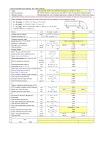
TABLE OF CONTENTS FOR THE WELDING HANDBOOK
- INTRODUCTION
- STAINLESS STEEL WELDING CHARACTERISTICS
- MARTENSITIC STAINLESS STEELS
- FERRITIC STAINLESS STEELS
- PRECIPITATION HARDENING STAINLESS STEELS
- WELD ROD SELECTION
- WELDING PROCESSES FOR STAINLESS STEELS
- WELDING DISSIMILAR METALS
- USE OF CHILL BARS
- JOINT DESIGN
- POST/WELD CLEANING AND FINISHING
- SOFT SOLDERING
- BRAZING
International publication Joining of Stainless Steels. The Committee of Stainless Steel Producers no longer exists.
The Nickel Development Institute (www.nidi.org) has reprints of this handbook titled “Welding of Stainless Steels and Other Joining Methods” (A designer handbooks series No. 9 002).
It should be noted that the data are typical or average values. Materials specifically suggested for applications described herein are made solely for the purpose of illustration to enable the reader
to make his own evaluation.
It should be noted that the data are typical or average values. Materials specifically suggested for applications described herein are made solely for the purpose of illustration to enable the reader
to make his own evaluation.
The Nickel Development Institute reprinted it for distribution in August 1988. Material presented in the hand-book has been prepared for the general information of the reader and should not be used or relied on for specific applications without first securing competent advice.
100 stainless steel alloys. Three general classifications are used to identify stainless steels. They are: 1. Metallurgical Structure; 2. The AlSl numbering system: namely 200, 300, and 400 Series numbers; 3. The Unified Numbering System, which was developed by American Society for Testing
Materials (ASTM) and Society of Automotive Engineers (SAE) to apply to all commercial metals and alloys. Stainless steels are engineering materials capable of meeting a broad range of design criteria.
Introduction
Stainless steels are iron-base alloys containing 10.5% or more chromium. They have been used for many industrial, architectural, chemical, and consumer applications for over a half century. Reference is often made to stainless steel in the singular sense as if it were one material. Actually there are well over100 stainless steel alloys. Three general classifications are used to identify stainless steels. They are: 1. Metallurgical Structure; 2. The AlSl numbering system: namely 200, 300, and 400 Series numbers; 3. The Unified Numbering System, which was developed by American Society for Testing
Materials (ASTM) and Society of Automotive Engineers (SAE) to apply to all commercial metals and alloys. Stainless steels are engineering materials capable of meeting a broad range of design criteria.
They exhibit excellent corrosion resistance, strength at elevated temperature, toughness at cryogenic temperature, and fabrication characteristics and they are selected for a broad range of consumer, commercial, and industrial applications.They are used for the demanding requirements of chemical
processing to the delicate handling of food and pharmaceuticals. They are preferred over many other
materials because of their performance in even the most aggressive environments, and they are fabricated by methods common to most manufacturers.
processing to the delicate handling of food and pharmaceuticals. They are preferred over many other
materials because of their performance in even the most aggressive environments, and they are fabricated by methods common to most manufacturers.
In the fabrication of stainless steel products, components, or equipment, manufacturers employ welding as the principal joining method. Stainless steels are welded materials, and a welded joint can provide optimum corrosion resistance, strength, and fabrication economy. However, designers should recognize that any metal, including stainless steels, may undergo certain changes during welding. It is necessary,
therefore, to exercise a reasonable degree of care during welding to minimize or prevent any deleterious effects that may occur, and to preserve the same degree of corrosion resistance and strength in the weld zone that is an inherent part of the base metal.
therefore, to exercise a reasonable degree of care during welding to minimize or prevent any deleterious effects that may occur, and to preserve the same degree of corrosion resistance and strength in the weld zone that is an inherent part of the base metal.
The purpose of this booklet is to help designers and manufacturing engineers achieve a better understanding of the welding characteristics of stainless steels, so they may exercise better control over the finished products with respect to welding. In addition to welding, other ancillary joining
methods are discussed, including soldering and brazing.
methods are discussed, including soldering and brazing.












0 Comments